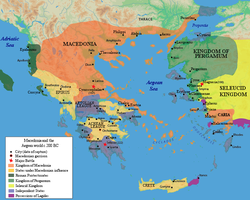Cyme (Aeolis)
| Cyme | ||||||||||
| Κύμη | ||||||||||
|
||||||||||
|
|
||||||||||
|
Map of Asia Minor showing the location of Kyme
|
||||||||||
| Capital | Kymi | |||||||||
| Languages | Aeolic, Ionic Greek | |||||||||
| Religion | Greek Polytheism | |||||||||
| Government | Tyranny | |||||||||
| Historical era | Classical Antiquity | |||||||||
| • | Established | 8th century BC | ||||||||
| • | Colony established | c. 700 – 600 BC | ||||||||
| • | Persian Conquest | 542 BC | ||||||||
| • | Ionian Revolt | 499 BC – 493 BC | ||||||||
| • | Macedonian Empire | 336 – 323 BC | ||||||||
| • | Attalid dynasty | 241 BC – 133 BC | ||||||||
| • | Disestablished | 241 BC | ||||||||
|
||||||||||
![]()
Silver tetradrachm of Cyme, 165–140 BC
Cyme (modern Turkish Nemrut Limani) was an Aeolian city in Aeolis (Asia Minor) close to the kingdom of Lydia.
The Aeolians regarded Cyme as the largest and most important of their twelve cities, which were located on the coastline of Asia Minor (modern-day Turkey). As a result of their direct access to the sea, unlike most non-landlocked settlements of the ancient world, trade is believed to have prospered.
Both the author of the 'life of Homer' and Strabo the ancient geographer, locate Cyme north of the Hermus river on the Asia Minor coastline, modern-day "Nemrut Limanı"(in Turkish)
After crossing the Hyllus, the distance from Larissa to Cyme was 70 stadia, and from Cyme to Myrina was 40 stadia. (Strabo: 622)
Archaeological finds such as coins give reference also to a river, believed to be that of the Hyllus.
Little is known about the foundation of the city to supplement the traditional founding legend. Settlers from mainland Greece (most likely Euboea) migrated across the Aegean Sea during the Late Bronze Age as waves of Dorian-speaking invaders brought an end to the once mighty Mycenaean civilization some time around 1050 BC. During the Late Bronze Age and early Greek Dark Ages, the dialect of Cyme and the surrounding region of Aeolis, like that of neighboring island Lesbos, closely resembled the local dialect of Thessalia and Boetia in continental Greece.
...
Wikipedia

